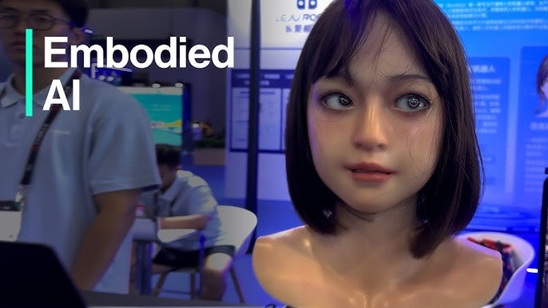
Introduction
This Bloomberg News report by Stephen Engle explores China’s rapid advancement in embodied AI – artificial intelligence systems integrated into physical robots and autonomous devices. Physical AI Video inside examines how China is positioning itself as a global leader in this emerging technology sector, from industrial automation to consumer robotics.
Physical AI: Bridging Digital Intelligence and the Physical World
What is Physical AI?
Physical AI, also known as embodied AI, refers to artificial intelligence systems that can understand, interact with, and manipulate the physical world through robotic bodies or physical agents. Unlike traditional AI that operates purely in digital spaces, Physical AI combines AI algorithms with sensors, actuators, and mechanical systems to create intelligent machines that can perceive and act in real-world environments.
Core Components
Perception Systems
- Computer Vision: Cameras and image processing for visual understanding
- Sensor Fusion: Combining data from multiple sensors (LiDAR, ultrasonic, infrared)
- Spatial Awareness: Understanding 3D environments and object relationships
- Real-time Processing: Immediate interpretation of sensory input
Decision-Making
- Large Language Models: Natural language understanding and generation
- Multimodal AI: Processing visual, auditory, and tactile information simultaneously
- Reinforcement Learning: Learning from interactions with the environment
- Path Planning: Determining optimal routes and actions
Physical Interaction
- Robotic Manipulation: Precise control of arms, hands, and tools
- Locomotion: Walking, rolling, flying, or other movement capabilities
- Force Control: Applying appropriate pressure and handling delicate objects
- Adaptive Behavior: Adjusting actions based on feedback
Key Applications
Industrial and Manufacturing
- Automated Assembly: Robots performing complex manufacturing tasks
- Quality Inspection: AI-powered visual inspection systems
- Warehouse Automation: Intelligent sorting, picking, and inventory management
- Predictive Maintenance: Robots that can diagnose and repair equipment
Healthcare and Assistance
- Surgical Robots: Precision-guided medical procedures
- Elder Care: Robots assisting with daily activities and monitoring health
- Rehabilitation: Physical therapy and mobility assistance devices
- Hospital Logistics: Automated delivery of supplies and medications
Transportation and Mobility
- Autonomous Vehicles: Self-driving cars, trucks, and delivery vehicles
- Drones: Delivery, surveillance, and inspection applications
- Marine Robotics: Underwater exploration and maintenance
- Agricultural Automation: Autonomous farming equipment and crop monitoring
Consumer and Service
- Household Robots: Cleaning, cooking, and general home assistance
- Security Systems: Intelligent surveillance and patrol robots
- Entertainment: Interactive robotic pets and companions
- Retail: Customer service robots and automated checkout systems
Technical Challenges
Real-World Complexity
- Unstructured Environments: Adapting to unpredictable, changing conditions
- Safety Requirements: Ensuring reliable operation around humans
- Robustness: Handling equipment failures and unexpected situations
- Generalization: Performing well across diverse scenarios
Integration Challenges
- Latency: Real-time processing requirements for safe operation
- Power Management: Balancing computational needs with battery life
- Cost Optimization: Making systems economically viable
- Scalability: Deploying solutions across multiple environments
Current State and Future Outlook
Leading Companies and Technologies
- Tesla: Optimus humanoid robots and Full Self-Driving technology
- Boston Dynamics: Advanced locomotion and manipulation robots
- Figure AI: General-purpose humanoid robots with LLM integration
- Chinese Companies: Unitree, Ubtech, and others driving cost-effective solutions
Emerging Trends
- Foundation Models for Robotics: Large-scale training on diverse robotic tasks
- Sim-to-Real Transfer: Training in simulation then deploying to real robots
- Human-Robot Collaboration: Seamless interaction between humans and AI agents
- Edge Computing: Processing AI models directly on robotic hardware
Market Projections
The global Physical AI market is expected to grow exponentially, with estimates suggesting it could reach hundreds of billions in value within the next decade, driven by advances in AI models, improved hardware capabilities, and decreasing costs.
Video of China’s Embodied AI
Key Sections of this Video
China’s Market Dominance Claims
China’s Ministry of Industry and Information Technology reports that the country has produced nearly 100 embodied AI robotic products since last year, claiming a commanding 70% share of the global market. This dominance is attributed to China’s comprehensive supply chain capabilities and advances in AI chip technology.
Massive Government Investment
The Chinese government has established a substantial $138 billion venture fund specifically targeting humanoid robot development for both industrial and personal applications. This represents unprecedented state-level commitment to the sector.
Booming Job Market
The embodied AI sector is creating significant employment opportunities in China’s challenging job market. Online recruitment data shows job openings in humanoid robotics have quadrupled year-over-year, with algorithm engineers commanding salaries well above urban averages.
Consumer and Industrial Applications
The report highlights specific products like Unitary’s G1 humanoid robot ($16,000) and the more affordable Goto robot ($600), demonstrating the range from premium to accessible consumer options. Industrial applications include Lenovo’s six-legged Daystar inspection robot for hazardous environments.
Physical AI Impact on SEA: Transforming the Region’s Economic Landscape
Current Landscape in Southeast Asia
Regional Adoption Patterns
Southeast Asia presents a diverse technological landscape with varying levels of Physical AI adoption. Singapore leads as a regional hub for robotics and AI innovation, while Thailand, Malaysia, and Vietnam are rapidly integrating automation in manufacturing. Indonesia and the Philippines are in earlier adoption phases, focusing primarily on logistics and basic automation.
Manufacturing Integration
The region’s position as a global manufacturing center makes it particularly susceptible to Physical AI transformation. Countries like Thailand (automotive), Vietnam (electronics), and Malaysia (semiconductors) are increasingly deploying automated inspection systems, assembly robots, and AI-powered quality control to maintain competitive advantages.
Economic Opportunities
Manufacturing Revolution
- Electronics Assembly: Vietnam and Malaysia’s electronics sectors could benefit from precision robotics for smartphone and semiconductor assembly
- Automotive Production: Thailand’s automotive hub could leverage Physical AI for electric vehicle manufacturing and autonomous vehicle testing
- Textile Automation: Bangladesh, Vietnam, and Cambodia’s garment industries could implement AI-powered cutting and sewing systems
Infrastructure Development
- Smart Cities: Singapore’s smart nation initiative and Malaysia’s digital economy blueprint incorporate Physical AI for traffic management, waste collection, and urban planning
- Port Automation: Major ports in Singapore, Malaysia, and Thailand are adopting AI-powered container handling and logistics optimization
- Construction Robotics: Rapid urbanization across the region creates demand for automated construction and building maintenance systems
Agriculture Modernization
- Precision Farming: Indonesia, Thailand, and Vietnam could deploy AI-powered drones and autonomous tractors for crop monitoring and harvesting
- Aquaculture: Region’s significant aquaculture industry could benefit from automated feeding systems and water quality monitoring
- Supply Chain Optimization: AI-powered cold storage and transportation systems for the region’s agricultural exports
Labor Market Transformation
Job Displacement Risks
- Manufacturing Workers: Potential displacement of assembly line workers, particularly affecting countries with large manufacturing workforces
- Logistics Personnel: Warehouse and delivery jobs at risk from autonomous systems
- Service Sector: Basic service roles in retail and hospitality vulnerable to robotic replacement
New Opportunities
- Technical Skills: Growing demand for robotics engineers, AI specialists, and automation technicians
- Human-Robot Collaboration: Roles requiring creativity, problem-solving, and interpersonal skills remain secure
- Maintenance and Support: Need for Physical AI system maintenance and troubleshooting across industries
Regional Challenges
Infrastructure Limitations
- Digital Divide: Rural areas lacking reliable internet and power infrastructure needed for Physical AI systems
- Transportation Networks: Inadequate roads and logistics infrastructure limiting autonomous vehicle deployment
- 5G Coverage: Uneven network coverage affecting real-time AI communication requirements
Economic Disparities
- Investment Capacity: Smaller economies may struggle to afford initial Physical AI implementation costs
- Technology Access: Limited access to cutting-edge AI technologies compared to developed markets
- Skills Gap: Shortage of technical talent for Physical AI development and maintenance
Regulatory Environment
- Safety Standards: Inconsistent safety regulations across countries for autonomous systems
- Data Privacy: Varying data protection laws affecting AI system deployment
- Cross-Border Trade: Different standards potentially hindering regional AI technology trade
Government Initiatives and Investment
National AI Strategies
- Singapore: $500 million AI Singapore initiative includes significant Physical AI research funding
- Thailand: Thailand 4.0 strategy incorporates robotics and automation as key pillars
- Malaysia: Digital Economy Blueprint allocates resources for AI and robotics development
- Vietnam: National AI strategy emphasizes manufacturing automation and smart agriculture
Regional Collaboration
- ASEAN Smart Cities Network: Collaborative framework for sharing Physical AI urban solutions
- Industry 4.0 Initiatives: Regional partnerships for manufacturing automation standards
- Research Cooperation: Cross-border academic and industry research programs
Sector-Specific Impacts
Healthcare Systems
- Surgical Robotics: Advanced medical centers in Singapore and Thailand adopting AI-powered surgical systems
- Elder Care: Aging populations in Thailand and Singapore driving demand for care robots
- Medical Logistics: AI-powered drug delivery and hospital automation systems
Tourism and Hospitality
- Service Robots: Hotels and airports across the region implementing AI concierge and cleaning systems
- Language Processing: Multilingual AI systems crucial for the region’s diverse linguistic landscape
- Autonomous Tours: Self-driving tour vehicles and AI guides for cultural sites
Financial Services
- Banking Automation: Physical AI for secure cash handling and customer service
- Insurance Assessment: AI-powered damage assessment and claims processing
- Fraud Prevention: Physical security systems with AI recognition capabilities
Future Outlook and Strategic Recommendations
Short-term Prospects (2-5 years)
- Pilot Programs: Expanded testing of autonomous delivery systems in urban centers
- Manufacturing Upgrades: Increased adoption of collaborative robots in existing factories
- Skills Development: Regional training programs for Physical AI technical roles
Long-term Vision (5-15 years)
- Autonomous Transportation: Widespread deployment of self-driving vehicles in major cities
- Smart Agriculture: AI-powered farming systems transforming rural economies
- Regional AI Hub: Potential emergence of Southeast Asia as a global Physical AI manufacturing and deployment center
Strategic Recommendations
- Regional Standards: Develop common safety and interoperability standards for Physical AI systems
- Education Investment: Massive reskilling programs to prepare workforce for AI-integrated industries
- Infrastructure Development: Accelerate 5G and digital infrastructure deployment
- Innovation Ecosystems: Foster startup incubators and research centers focused on Physical AI
- Inclusive Growth: Ensure smaller economies and rural areas benefit from Physical AI advances
Physical AI represents a fundamental shift from digital-only intelligence to AI systems that can meaningfully interact with our physical world, promising to transform industries and daily life while raising important questions about safety, ethics, and the future of human-machine collaboration.
Conclusion and Key Takeaways
Implications and Considerations
Economic Impact
- Job Transformation: Automation of physical tasks across industries
- Productivity Gains: Significant efficiency improvements in manufacturing and services
- New Industries: Emergence of robot-as-a-service and AI maintenance sectors
Societal Considerations
- Safety Standards: Need for comprehensive regulations and testing protocols
- Privacy Concerns: Data collection through sensors and cameras
- Human-AI Interaction: Designing intuitive and trustworthy robotic systems
- Accessibility: Ensuring benefits reach diverse populations and use cases
Physical AI presents both tremendous opportunities and significant challenges for Southeast Asia. The region’s manufacturing strength, young population, and growing digital infrastructure position it well to benefit from Physical AI adoption. However, success will require coordinated regional efforts to address infrastructure gaps, develop human capital, and ensure equitable access to these transformative technologies. Countries that proactively invest in Physical AI capabilities while managing social and economic transitions are likely to emerge as regional leaders in this new technological paradigm.
Key Points:
China’s embodied AI push represents a strategic technological shift with significant economic implications:
- Market Leadership: China claims 70% global market share in embodied AI robotics
- State Support: $138 billion government investment signals long-term commitment
- Employment Growth: 4x increase in sector job openings indicates rapid industry expansion
- Competitive Pricing: Chinese robots positioned as high-value, cost-effective solutions
- Diverse Applications: From $600 consumer pets to $16,000 humanoids and industrial inspection bots
Bottom Line: China’s combination of manufacturing capabilities, state funding, and AI expertise positions it to potentially dominate the emerging embodied AI market, though questions remain about real-world impact and commercial viability.


